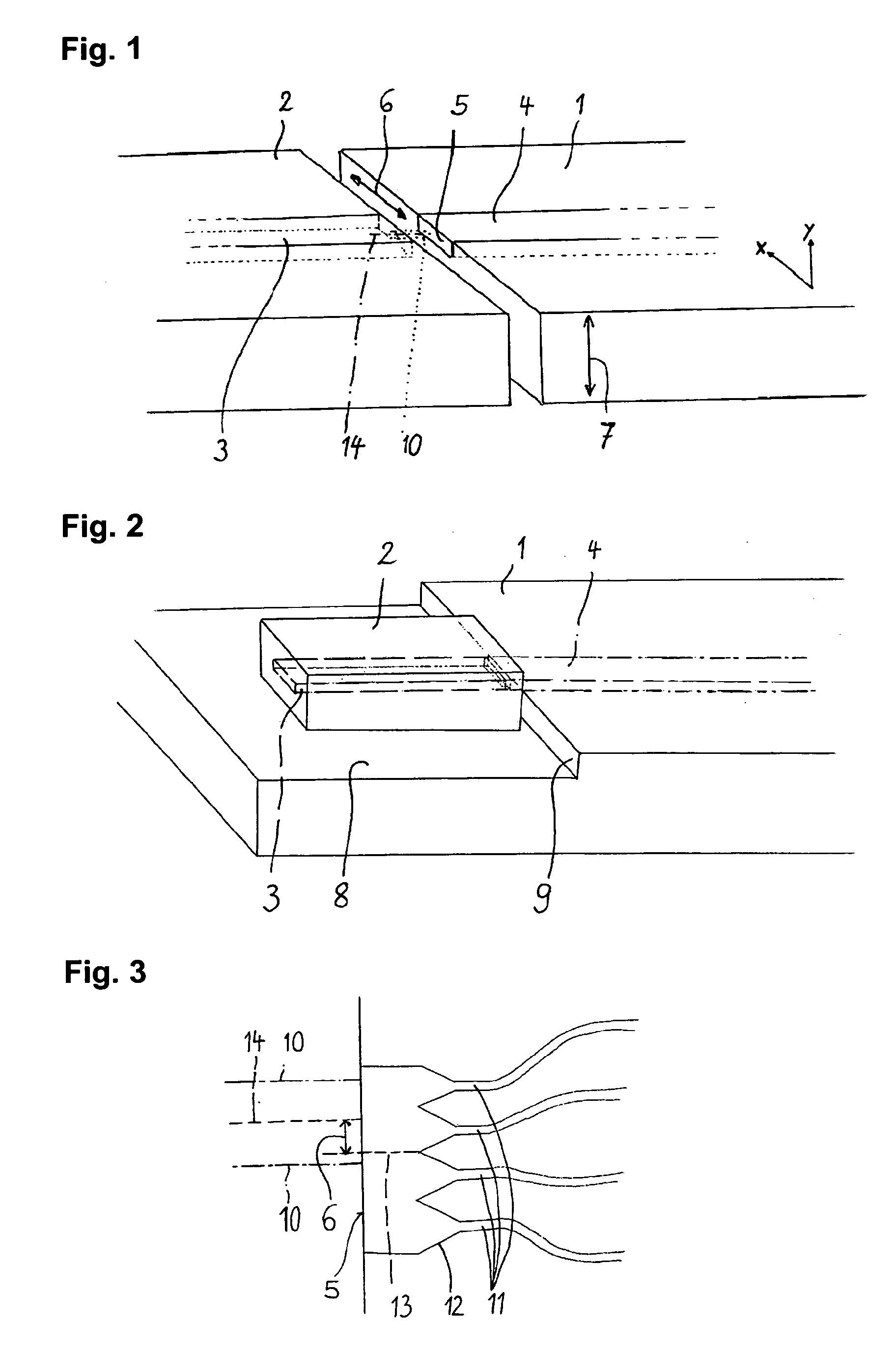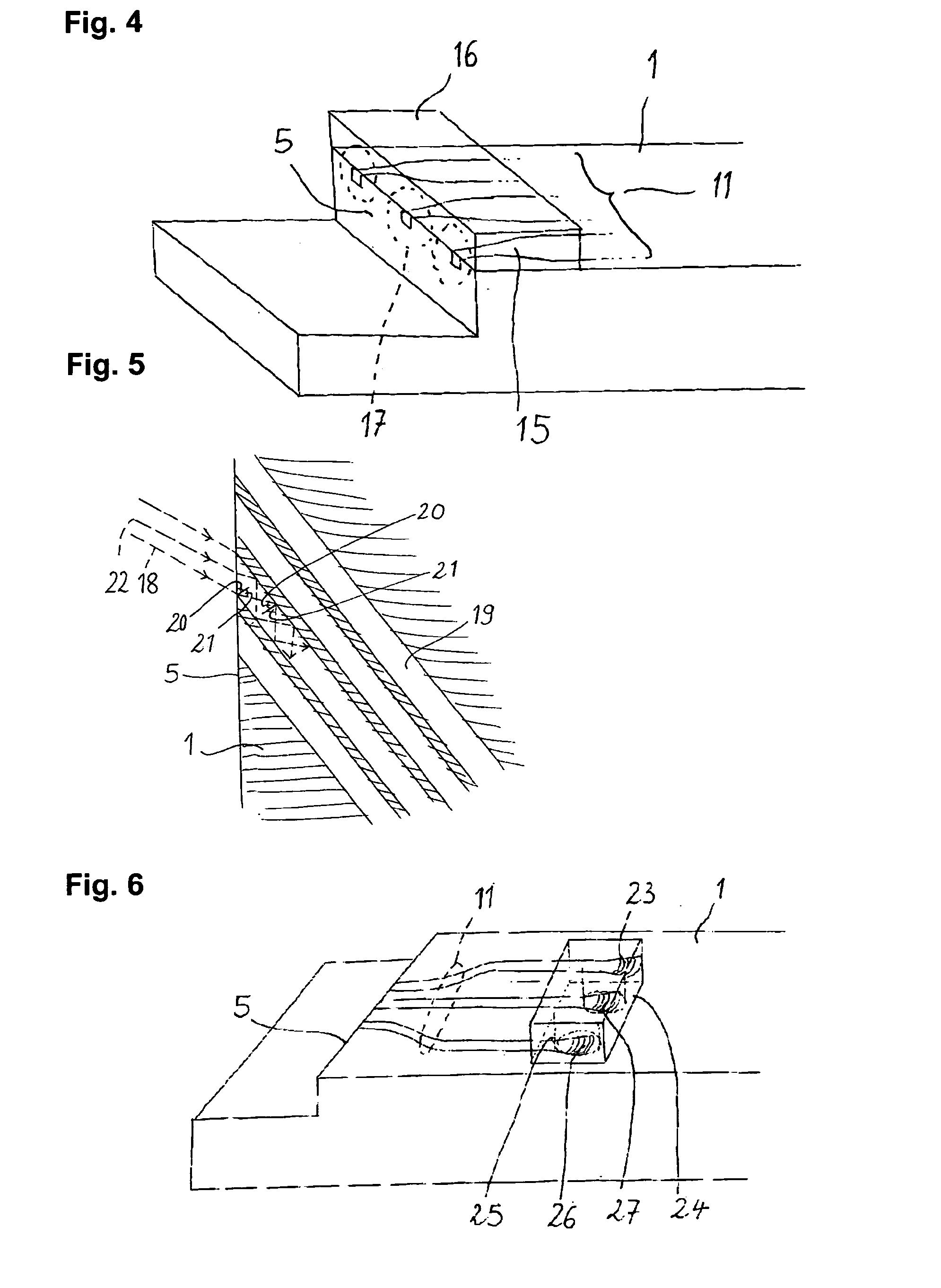A major difficulty remains however with coupling light on and off from optical chips.
This creates a dual problem of having to focus light from an
optical fiber down to the dimensions of on chip high-index contrast waveguides and of having to precisely align the position of the
optical fiber relative to the
semiconductor chip.
However, such
grating couplers also induce other constraints.
For one, such coupling schemes often only work for one polarization, or when they work for two polarizations they create additional complications such as the necessity of two photonic chip waveguides with uneven coupling from the
fiber to the two waveguides depending on the state of polarization of the light.
These methods are also poorly suited for
direct coupling from a
laser diode to a primary photonic chip, since the dimensions of the laser beam are significantly smaller than the
grating coupler dimensions in at least one dimension, as the typical dimension of the laser beam in the direction perpendicular to the
laser diode chip surface is on the order of 1 μm and typical
grating coupler dimensions are of at least several microns.
However, constraints relative to uneven coupling depending on polarization and stringent alignment tolerances remain.
Constraints relating to stringent alignment tolerances are difficult to satisfy and lead to high manufacturing costs not only because the alignment has to be established during
assembly, but also because alignment has to be maintained after
assembly, thus requiring very stable and reliable
optical packaging solutions and leading to yield fallout.
However, this method suffers from the fact that alignment tolerances are directly determined by the dimensions of the
waveguide cross-section at the chip interface and are typically sub-micron for
high index contrast waveguides.
Also,
assembly can be complicated due to the fact that the edge of the chip offers very little area to permanently attach a
fiber or a laser, as opposed to the chip surface in the prior methods that allow permanently gluing a
fiber,
fiber array,
laser diode, laser submount or optical bench to the chip surface.
This is a very costly packaging technology.
While it is straightforward to widen the
waveguide in the direction along the chip surface, by simply drawing a wider lithographically defined
waveguide, it is much more difficult to taper a waveguide in the vertical direction perpendicular to the photonic chip surface since in the latter case the dimensions are determined by the dimensions of deposited thin film
layers.
Thin films typically used in semiconductor chips, such as
silicon, poly-
silicon or
silicon oxi-nitrides in the case of
silicon based photonics are both difficult to fabricate with slanted cross-sections for tapering in the vertical direction and to deposit in thick enough
layers to match an
optical fiber cross-section.
This method can result in technical constraints.
This complicates manipulation of the laser
diode as it has to be electrically contacted and it constrains the alignment process as the
diode has to remain cold enough in order to be operated.
However, this tolerance remains too high to passively butt-couple a typical semiconductor laser to a
high index contrast waveguide.
In this case, a misalignment by 1 or a few microns in the horizontal direction due to the tolerance of a passively aligned pick-and-place
system very adversely effects the
coupling efficiency between the laser diode and a waveguide located on the primary photonic chip.
Tapering the horizontal dimension to a much wider width than the width of the laser beam significantly relaxes the required alignment tolerance, but also reduces the
coupling efficiency obtained under optimum coupling conditions if the laser beam width is not increased accordingly, hence there is a trade-off between the peak
coupling efficiency and the required alignment tolerance.
This is caused by the fact that widening of the waveguide without widening of the laser beam results in a mode overlap mismatch that reduces the coupling efficiency in a single mode
system, i.e., in a
system where the coupled to waveguide on the primary photonic chip is single mode for at least a portion of its path.
This approach is however limited both by technical and economic considerations.
Filamentation can result in a complex laser beam profile that can also change over time, both of which prevent efficient coupling of the laser beam into single mode photonic waveguides on the primary photonic chip.
Widening the laser strip in conventional technology can also be difficult since it can make it harder to efficiently and homogenously electrically pump the laser beam.
Other methods to increase the width of the laser beam, such as tapering the laser strip close the edge of the laser chip typically results in increased manufacturing cost.
Since the optical
gain material on the laser diode chip results in high optical losses when it is not pumped, and since pumping it efficiently in the broadened laser strip region is both technically challenging and leads to excess
current consumption, it is typically necessary to selectively remove the laser
gain material in the tapered region and to selectively regrow another material in its stead.
This is a very expensive and typically poorly yielding process.
In practice, however, the
vertical alignment accuracy is limited by the attachment process.
However, they also require ultra planar surfaces on both the laser chip and on the photonic chip.
With these bonding methods electrical contacting between the top surface of the laser chip and the top surface of the photonic chip is also complex since the adhesion does not occur via a conductive layer.
They result however in degraded
vertical alignment accuracy on the order of a few 100 nm, since the bonding layer can get more or less compressed.
At the extreme, controlled collapse
bump bonding is very tolerant to high particle count (dust) and non-planar topographies, but results in very poor
vertical alignment control, with tolerances of at least one to several micrometers.
As with horizontal alignment tolerances, this alignment tolerance relaxation method is limited by the fact that a vertical waveguide dimension substantially larger than the vertical laser beam dimension leads to reduced overlap and reduced peak coupling efficiency.
The difficulty in coupling to a single mode waveguide located on a primary photonic chip from an incoming input
light beam external to the primary photonic chip results from the reciprocity principle.
A misalignment of the input beam on the same order than the
full width at half maximum of the input beam will thus lead to a substantial reduction of coupling efficiency if the input beam is well matched to the
waveguide mode.
 Login to View More
Login to View More 


